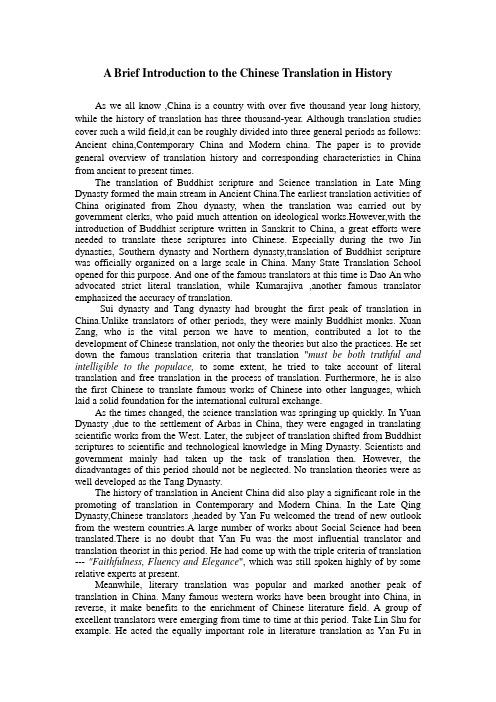history of translation
- 格式:ppt
- 大小:2.04 MB
- 文档页数:51


Part 2 History of Translation有文字记载的翻译实践活动,远在公元前三千年就存在了。
(亚述王国Assyria国王萨尔贡Sargon);中国的起始时期:周朝(春秋战国时期)⏹“五方之民,言语不通,嗜欲不同,达其志,通其欲” ——《礼记》“东方曰寄,南方曰象,西方曰狄鞮,北方曰译” ——《礼记》⏹西方翻译史上,第一位重要的翻译理论家——西塞罗(古罗马著名学者106-43BC)I.History of Translation in the WestSix tides in five periods五个时期六个高潮●Ancient translation古代翻译:4th C BC —5th C AD翻译介绍希腊文化,促进罗马文学的诞生和发展●Medieval translation中世纪翻译;A. 罗马帝国后期——中世纪初期宗教翻译《圣经》的拉丁文译本与世俗文学翻译分庭抗礼B. 11、12世纪希腊典籍回归故里西班牙托莱多(成为欧洲学术中心)阿拉伯语译回拉丁语●Translation in Renaissance periods文艺复兴时期翻译:翻译活动达到前所未有的高峰,涉及到思想、政治、哲学、文学和宗教等,产生了大批杰出的翻译家和一系列优秀的翻译作品●Modern translation近代翻译17世纪下半叶——20世纪上半叶,继续古典著作的翻译,关注近当代的作品,如莎士比亚、巴尔扎克、东方文学●Contemporary translation当代翻译:二战以后,翻译翻译范围翻译规模扩大2. Tr anslators and translation theorists西塞罗,贺拉斯,哲罗姆,德莱顿,泰特勒,奈达,卡特福德,纽马克,巴斯内特,勒菲弗尔,图瑞II.History of Translation in China文字翻译始于汉代的佛经翻译⏹佛经翻译——中国文化的深层迁移⏹明清时期的翻译——中国近代科学和国人的科学素养与科学精神⏹五四及民国时期的翻译——中国近代思想的历史演进⏹建国后的翻译活动——对中国文化及其知识、学术、思想具有类似的模筑作用三国时期佛经翻译家支谦、维祗之间的争论,是首次对翻译问题进行的探讨,信、达、雅均以涉及。

A Brief Introduction to the Chinese Translation in HistoryAs we all know ,China is a country with over five thousand year long history, while the history of translation has three thousand-year. Although translation studies cover such a wild field,it can be roughly divided into three general periods as follows: Ancient china,Contemporary China and Modern china. The paper is to provide general overview of translation history and corresponding characteristics in China from ancient to present times.The translation of Buddhist scripture and Science translation in Late Ming Dynasty formed the main stream in Ancient China.The earliest translation activities of China originated from Zhou dynasty, when the translation was carried out by government clerks, who paid much attention on ideological works.However,with the introduction of Buddhist scripture written in Sanskrit to China, a great efforts were needed to translate these scriptures into Chinese. Especially during the two Jin dynasties, Southern dynasty and Northern dynasty,translation of Buddhist scripture was officially organized on a large scale in China. Many State Translation School opened for this purpose. And one of the famous translators at this time is Dao An who advocated strict literal translation, while Kumarajiva ,another famous translator emphasized the accuracy of translation.Sui dynasty and Tang dynasty had brought the first peak of translation in China.Unlike translators of other periods, they were mainly Buddhist monks. Xuan Zang, who is the vital person we have to mention, contributed a lot to the development of Chinese translation, not only the theories but also the practices. He set down the famous translation criteria that translation "must be both truthful and intelligible to the populace, to some extent, he tried to take account of literal translation and free translation in the process of translation. Furthermore, he is also the first Chinese to translate famous works of Chinese into other languages, which laid a solid foundation for the international cultural exchange.As the times changed, the science translation was springing up quickly. In Yuan Dynasty ,due to the settlement of Arbas in China, they were engaged in translating scientific works from the West. Later, the subject of translation shifted from Buddhist scriptures to scientific and technological knowledge in Ming Dynasty. Scientists and government mainly had taken up the task of translation then. However, the disadvantages of this period should not be neglected. No translation theories were as well developed as the Tang Dynasty.The history of translation in Ancient China did also play a significant role in the promoting of translation in Contemporary and Modern China. In the Late Qing Dynasty,Chinese translators ,headed by Yan Fu welcomed the trend of new outlook from the western countries.A large number of works about Social Science had been translated.There is no doubt that Yan Fu was the most influential translator and translation theorist in this period. He had come up with the triple criteria of translation --- "Faithfulness, Fluency and Elegance", which was still spoken highly of by some relative experts at present.Meanwhile, literary translation was popular and marked another peak of translation in China. Many famous western works have been brought into China, in reverse, it make benefits to the enrichment of Chinese literature field. A group of excellent translators were emerging from time to time at this period. Take Lin Shu for example. He acted the equally important role in literature translation as Yan Fu insocial science translation. Regarded as the pioneer of literature translation in China, he opened a new Chapter for Chinese translation.Compared to the two former period, translation work in Modern China has a wider coverage,such as the translation of socialist and communist works,literature works and so on.The May 4th Movement was a famous activity happened in the Chinese history,which was also the starting point of the new democratic revolution in China. Great changes have taken place in translation in China. Karl Marx's (1818-1883) and Lenin's works on socialist and communist theories were the focus of our translation work , as it will guide the direction of our revolution. What’s more, literary translation was different from the past.The quality and quantity of literary translation were greatly improved. No matter where it comes from,the world famous literary works were translated into Chinese. Translators as Lin Yutang, Lu Xun and Qu Qiubai were the three most famous .The translation theory was completed during this period of time,one of them was put forward by Lin,that is his three translation criteria:the first is fidelity,the second is coherence,the third is elegance.However, the heated topics on translation theory were still translation criteria, literary vs free translation.Even any little progress in the history of Chinese translation still means a huge leap to the development of our society. Without these efforts, China may haven’t avoided the mistakes that other countries have made, nor learned from the advanced technology around the world. Despite the achievement on translation theory we have already got, it turned out to be a failure to guide translation practice without any difficulty.There is still a long way ahead. To be in accordance with booming economy and the expansion of its political influence in the international community,China will continue to strive unremittingly all the time.。



一.劳伦斯·韦努蒂的基本信息及其主张:劳伦斯·韦努蒂 Lawrence Venuti(1953年—)学者,大学英语教授,专职翻译家,美籍意大利人,生于费城南部(此区域居住者多为意大利裔),七十年代早期在天普大学攻读英语文学,1980年获哥伦比亚大学博士学位。
主要著作:主编论文集《对翻译的重新思考:语篇、主体性与意识形态》(RethinkingTranslation: Discourse, Subjectivity,Ideology),(1992)、《译者的隐身一部翻译史》(Translator's Invisibility: A History ofTranslation)(1995)《不光彩的翻译》(The Scandals of Translation: Towards anEthics of Difference)(1998).韦努蒂把解构主义的翻译思想付诸实施,提出了反对译文通顺的翻译策略。
其目的是:在思想意识上反对殖民主义的翻译观和英美民族中心主义和帝国主义文化价值观;在翻译原则和方法上,提创“存异”而不是“求同”。
通过对英美翻译历史的研究,他得出英美文化中译者和译作实际上处于“隐形”状态。
造成译者隐形的原因是由于归化翻译是英美翻译界的主流翻译方法所致。
鉴于归化翻译是英美翻译作品是主流翻译方法,而译者在这些翻译作品中都是“隐形人”。
Venuti主张“异化”翻译,号召译者采取抵抗翻译策略,以显示自己在翻译中的存在。
Venuti的异化翻译法归因于19世纪德国哲学家Schleiermacher的翻译论说:the translator leaves the author in peace, as much as possible, and moves the reader towards him. “译者尽量不惊动原作者,让读者向他靠近。
”VENUTI异化翻译理论中存在的问题:由于Venuti过分关注政治对翻译方法的影响,其所提倡的异化翻译理论忽视了文学翻译的主要目的,没有考虑到接受者的需求。
History of TranslationTeaching PlanTeaching Contents:1. An introduction to Chinese translation theory and history2. An introduction to western countries translation theory and history中国翻译史的大致分期1.由汉代到唐宋的上千年的佛经翻译【支谦、道安、鸠摩罗什、昙无谶、法显、谢灵运、真谛、彦琮、慧远、玄奘、不空】2.明清交替之际的科技翻译【徐光启、利玛窦、汤若望、南怀仁、熊三拔、李之藻等】3.清末民初的文学和科技翻译【李善兰、华蘅芳、傅兰雅、林纾、严复、梁启超等】4. 民国时期的翻译【赵元任、朱生豪、林语堂】5. 新中国成立后的翻译,尤其是改革开放以来的翻译【傅雷、钱钟书、杨绛】Lecture 1 佛经翻译I.关于翻译的早期记载《册府元龟·外臣部·鞮(di)译》记载,周时有越裳国“以三相胥重译而献白雉,曰:‘道路悠远,山川阻深,音使不通,故重译而朝’”。
“五方之民,言语不通,嗜欲不同。
达其志,通其欲,东方曰寄,南方曰象,西方曰狄鞮,北方曰译。
”《礼记·王制》翻译的不同称呼:“象寄”、“象胥”、“鞮译”“舌人”寄send; entrust; rely on象be like; resemble; image译translate; interpret越人歌今夕何夕兮?搴舟中流。
今日何日兮?得与王子同舟。
蒙羞被好兮,不訾诟耻。
心几烦而不绝兮,知得王子。
山有木兮木有枝,心悦君兮君不知。
《越人歌》是我国历史上现存的第一首译诗。
秦汉时期对“翻译官”的种种称谓:“行人”、“典客”、“大行令”、“大鸿胪”、“典乐”、“译官令”、“译官丞”等。
到汉朝,我国主要的外事活动是对北方的匈奴用兵,故翻译活动逐渐用“译”来统称了。